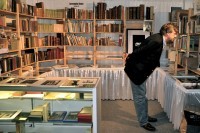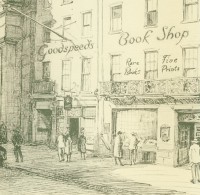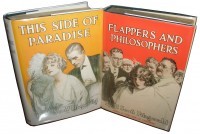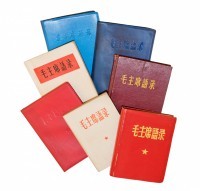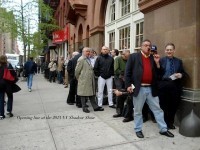This item is still missing as of 5/31/2019. A collector in the Los Angeles area reported the theft of the following item: Age of Innocence by Edith Wharton First Edition (1st Issue) in dust jacket. The book is housed in a blue half leather clamshell box. The dust jacket is unrestored and has a small tape repair on the verso of the jacket near the foot of the spine. A photo of the book is below. If you have any information concerning this book, please contact Mike Hurey at mhurey@kleinberglerner.com or at (310) 871-2646. [more Stolen: ‘Age of Innocence’, First Edition in Dust Jacket]
I've been asked to dredge up a few memories about the Boston book fair, the venues it occupied prior to its current home at the Hines Convention Center, and some of the dealers who exhibited in Boston in previous generations. Our firm, Howard S. Mott, Inc., is one of six firms to have exhibited at every Boston book fair since its inception in 1976, the upcoming fair being the 38th Annual. The others are Brattle Book Shop, Michael Ginsberg, aGatherin', Rulon-Miller, and Phil McBlain. The idea for the book fair came from Harold Burstein, and at the first exploratory meeting were Harold, Ken Gloss, Ken Rendell, and Mike Ginsberg. When the Boston Antiquarian Book Fair began our firm was still a member of the Mid-Atlantic Chapter of the ABAA. The firm started business life in New York City when there was no New England Chapter, and twenty years later, after my father and mother moved the family to Massachusetts in 1956, there was still no NE Chapter. When such a chapter was established my parents were slow to make the change. Thus, we were not involved with the creation of the fair. The early fairs were managed by Anne Bromer's mother, the indomitable Florence Finn. She was small in stature, but large in personality and authority. No problem was too big or too small for her, and she ran the show beautifully until she retired after something on the order of ten years at the helm. The first few fairs were held at the Copley Plaza Hotel, and they started slowly despite its ideal loca... [more Recollections Of The Boston Book Fair, By A Lifer]
Peter L. Stern introduces several notable characters in the Boston rare-book trade. I have been asked to write a blog for the ABAA along the lines of “characters in the Boston book trade.” I hardly know where to begin, but I'll give myself a pass and leave it to others to extoll my virtues and undisputed genius. My own career in the antiquarian trade started at the Starr Book Company on Kingston Street. This was very nearly where the Great Boston Fire (1872) originated, and our building was likely built on those ashes. It may have been 1972 outside, but inside it was a century earlier. We only had direct current, our heat came from a central Edison steam plant, and “air conditioning” was supplied by an industrial fan that sounded like a revving B-24. My morning's first task was to sweep the floor and then pack shipments, which were bundled with string. Remember packages tied by string? My starting pay was a princely $100 a week, but given the modest business that paid it, I never resented it, although more than once, I was very nearly felled by book avalanches. My boss, Ernie Starr, had been in the trade since the late thirties or early forties. He possessed a genuine enthusiasm and appreciation for books, even if he occupied a low rung on the ladder. He was originally in business with his brother Milt, a rather gruff man. Eventually, he and Ernie split up. Milt got Cambridge, Ernie got Boston. I particularly recall one anecdote Ernie told about their partnership. The... [more Boston: Characters in the Rare Book Trade]
A New England Correspondence Archive: Descriptive Notes and Approach to Valuation Recently a Massachusetts antiques dealer sought me out to evaluate an archive of approximately 100 autograph letters received by one Edward B. Dearborn (1807-1886), including many related to teaching, mostly in rural New England schools in the late 1820s and early 1830s. What at first appeared to be a boring batch of correspondence written by a group of nobodies turned out to be a fascinating window into the culture and practice of teaching in early 19th Century New England, and also provided a case study of how an appraiser assesses a unique collection of material that doesn't include traditionally collectible famous personalities. Most people are familiar with Teach for America, the organization that recruits “high-achieving” recent college graduates and professionals for two years of teaching service. Yet the idea of reaching into colleges to employ students or fresh graduates to teach in communities that lack educational opportunity is hardly new. The arrangement goes back at least to early 19th Century America, when students at colleges such as Dartmouth, Bowdoin, and Wesleyan often taught for a few months each year to gain income needed to continue their studies. Dearborn, the recipient of the letters, taught school for decades before being appointed as Librarian of the New England Genealogical Society. A graduate of Hampton (NH) Academy, he prepared for college, but never attended. At... [more Dear Mr. Dearborn…]
Although created almost a century ago, the art and writing of the Roaring 20's still captivates us today. Writer F. Scott Fitzgerald left behind some of the most iconic stories of this fascinating time period. The radical social change he wrote about was also evident in the art that adorned his dust jackets, as the artists who designed them had an uncanny ability to capture the zeitgeist of the era. Art imitated life, and Fitzgerald and his publishers knew how to captivate the attention of a younger generation, the ones who were behind all this change, like never before. Fitzgerald's first three dust jackets were designed by artist William E. Hill. Hill had made a name for himself illustrating for Puck magazine and the Sunday New York Tribune. His ability to depict everyday people in natural settings was well-known, so when Scribner's editor Maxwell Perkins needed to choose an artist for Fitzgerald's upcoming publications, he looked to this established artist. This Side of Paradise (1920) depicts an elegantly dressed young man and woman, portraying all the decadence and extravagance of the era. The cover art for Flappers and Philosophers (1920) features an illustration for perhaps the best story in the collection, “Bernice Bobs Her Hair.” The choice of both title and art for this book did well to make it a best-seller: the word “flappers” and the art showing a young girl cropping her hair in the latest style are at once attractive and provocative, easily capturing the... [more The Artists Behind F. Scott Fitzgerald’s Dust Jackets: Part I (1920-1923)]
The 1960s was a decade of both discovery and protest, riots and revolutions, from anti-war marches, assassinations of world leaders, man's first landing on the moon, and the birth of a new brand of music led by The Beatles. Change was in the air and nowhere was it more obvious than in modern China with the outbreak of the Cultural Revolution in August 1966. But more than two years earlier, before Chairman Mao ordered his Red Guards to restructure Society and re-educate intellectuals, there was the "Little Red Book" – a series of useful quotations gathered from Mao's earlier lectures and writings that would help guide his countrymen and women to deal with problems covering all aspects of daily life. The size of the book was small enough to fit inside a shirt pocket so it could be flush against the heart. Its phenomenal popularity may be because the book was essentially an unofficial requirement for every Chinese citizen to own, to read, to memorize and to carry copies at all times during the last ten years of Mao's rule, which essentially comprised the Cultural Revolution. Studying the book was not only required in schools but it also became a standard practice in the workplace. All units, in the industrial, commercial, agricultural, civil service, and military sectors, organized group sessions for the entire workforce to study the book during business hours that often extended into evening discussion meetings. During the middle to late 1960s, the book became the single most... [more 1964: The Little Red Book]
Enter the Blogosphere I promised another Facebook related post this week, but instead I think it's time to switch gears and get acquainted with some other social media options out there before you start to think that I'm on Mark Zuckerberg's payroll. This week I will consider the pros and cons of blogging as well as some of the better sites out there that support the endeavor. The fact that anyone with an internet connection and an email address can start a blog means that there is a huge range out there in terms of content as well as quality. And indeed, it sometimes feels like everyone and their cat has a blog these days. But as you will see, although it's a fairly easy thing to set up, it takes more than good intentions to sustain a blog over time. Nevertheless, the idea of having your own virtual soap box makes blogging an attractive option – and then of course there's always the hope that your blog will go viral and land you a six figure publishing contract and movie deal. Unfortunately, more often than not it will go something like this: Mr. Whiskers gets a great idea for a blog, writes two posts, and then gets “too busy” to update it for a year or three. Needless to say, don't follow Mr. Whiskers's example (I hear he's kind of aloof anyway). Blogging, like the rest of social media, takes a commitment from you in order to be a useful tool for your business. It can be a tougher pursuit in terms of time management because most blog entries tend to be quite a bit lon... [more THE SAVVY BOOKSELLER: Social Media for the Antiquarian Book Trade, Post #5]
This item is still missing as of 5/29/2019. The following item was reported missing from an apartment in Brooklyn: Duchamp, Marcel; Cage, John; Kubota, Shigeko (photographer). Marcel Duchamp and John Cage / Reunion. : Takeyoshi Miyazawa, . Oblong octavo, original blue cloth lettered in silver, clear dust jacket, blue endpapers. lllustrated with black-and-white photographs by Shigeko Kubota on rectos, acrostics by John Cage on versos. Hand-numbered 3 of 500 copies, inscribed by Shigeko Kubota on verso of front free endpaper: "David / with love Shigeko / 18 June '71." 33 rpm recording of the 1968 Duchamp/Cage Reunion chess match laid in. Tiny chips to spine ends of clear jacket. Housed in faded and scuffed blue card slipcase. First edition of this tribute to the celebrated 1968 chess match between Marcel Duchamp and John Cage, hand-numbered 3 of 500, inscribed by photographer Shigeko Kubota. If you have an information regarding this item, please contact Heather at: Honey & Wax Booksellers 540 President Street, Third Floor Brooklyn NY 11215 917-974-2420 heather@honeyandwaxbooks.com honeyandwaxbooks.com [more Missing: Duchamp, Marcel; Cage, John; Kubota, Shigeko (photographer)]
Back in the 1990s event promoter Bernice Bornstein saw an opportunity and took advantage of it. Her husband Marvin owned a parking lot directly across the street from the Hynes Auditorium, where the Boston International Antiquarian Book Fair was being held. “Why not have a smaller show for non-ABAA dealers that same weekend?” she asked. “We could use the basement of Marvin's garage.” Thus the first “Shadow Show” was born. The idea met intense resistance at first. Old-line ABAA dealers were concerned that another show would steal customers and dilute earnings. They feared the public would confuse the ABAA show, where rigid standards for dealers were enforced, with the non-ABAA show, where the only requirement was the ability to pay booth rent. They feared competition from dealers with lower overheads. They feared their stable price structures would be challenged by dealers out to make a quick buck. They feared a lot of things that never came to pass. Bernice's Shadow Show was a great success, and the old guard quickly realized that the existence of a second show benefited everyone. It wasn't long before promoters Garry Austin and Bruce Gventer transferred the Shadow Show model to the New York International Antiquarian Book Fair. This is the pre-eminent book fair in the country; one of the greatest in the world. By this time there was no doubt in anyone's mind that a second show would provide a tremendous opportunity for ABAA dealers to buy and for non-ABAA dealers ... [more Book Show Wars]
The following item was reported stolen from Monsey, NY on 10/10/14: (Bible in Hebrew) Vocalized text. Integral blanks present. This is 17 parts in 8 volumes. Samll format; 113 x 68mm. 16th century calf with gilt arabesque centerpiece on covers, vellum pastedowns from medieval Latin manuscript (of an abridgment?) of the Sentences of Peter Lombard. From the collection of the Scottish politician bibliophile Andrew Fletcher of Saltoun (1653-1716) with his signature on the title pages. If you have any information regarding this item, please contact Gene Albert at 301-988-6700 (daytime) or 301-331-5060 (evenings). [more Stolen: 8 Volume Hebrew Bible - Second Estienne Hebrew Bible]


